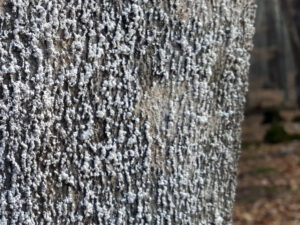
Lots of beech scale, covered in white wool, makes this tree’s bark look fluffy. / Photo Credit: Linda Williams, Wisconsin DNR
By Linda Williams, DNR Forest Health Specialist, Woodruff
Linda.Williams@wisconsin.gov or 920-360-0665
Last month, we introduced readers to the woolly alder aphid, which is easier to spot in the winter as the insects congregate on alder branches and grow strands of white, waxy material to cover themselves for winter.
But there are other white, fluffy things that you might notice on tree bark or branches as well.
Beech scale, the insect associated with beech bark disease, is covered in white wool and remains on the tree throughout the winter. In areas with high beech scale populations, the beech trees can be so white with insects that the bark looks white, like a birch.
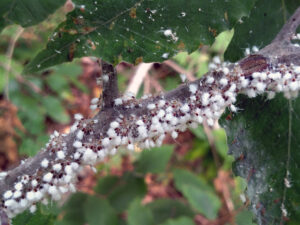
Beech blight aphids on a branch. Their abdomens are covered in white fluff. / Photo Credit: Linda Williams, Wisconsin DNR
Wisconsin is on the western edge of the native range of American beech, so beech is only found in the eastern quarter of the state. (Note that many people refer to musclewood as “blue beech,” but it’s not a true beech and therefore is not infested with beech scale).
During summer months, you can also find native beech blight aphids on American beech trees. These large aphids grow white, waxy filaments from their abdomens as they feed in large groups on the branches of beech trees. When disturbed, they all wave their abdomens dramatically to try to scare off predators.
Pine bark adelgid is a native insect that can be found on white pine, as well as Austrian pine and Scotch pine. The tiny insects can be found on tree trunks, as well as on branches near the base of needle bundles.
Pine bark adelgids grow a bit of white fluff over themselves to protect themselves from predators and parasites. They can be found on all ages of white pine. Heavy infestations can make the bark look white, due to all the wool.
There are two small, white fluffy insects that have yet to be detected in Wisconsin (as of January 2025), but please be watching for them:
- Hemlock woolly adelgid (HWA) is an invasive insect that attacks hemlock. The tiny insects insert their mouthparts at the base of a needle and remain there for the rest of their lives, eventually producing white fluff to protect themselves and their eggs. Heavy populations of HWA can cause decline and mortality of hemlocks.
- Balsam wooly adelgid (BWA) is an invasive insect that attacks true firs, including our native balsam fir. These tiny insects can be found on the main stem as well as on twigs.
If you think you’ve found either of these insects in a forest, please take a picture and send it to your Wisconsin Department of Natural Resources (DNR) forest health specialist for identification. If you think you’ve found it on a yard tree, please take a picture and submit it to the University of Wisconsin-Madison Extension’s Ask A Gardener page for identification.
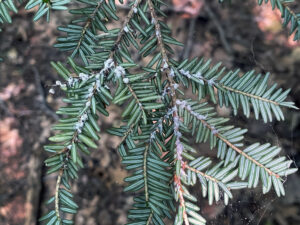
emlock woolly adelgids feed at the base of hemlock needles, covered in white wool. / Photo Credit: Linda Williams, Wisconsin DNR
Spider egg sacs, small cocoons and cottony material from cottonwood and aspen catkins also can be found on branches and needles.
And when conditions are right, an abiotic event (one not caused by insects, fungi or disease) can form white, fluffy ice on branches, known as “hair ice.”
Hair ice can form on dead branches when conditions are just right – including air temperature, the temperature of the dead branch and the presence of a decay fungus in the branch. Hair ice resembles needle ice, which forms on the ground from groundwater, but hair ice forms on dead branches from the water in the dead wood.
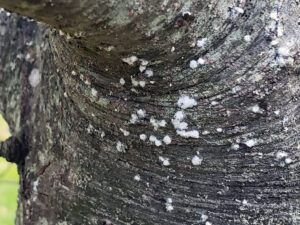
Tiny balls of wool cover each pine bark adelgid insect on the bark of a white pine tree. / Photo Credit: Linda Williams, Wisconsin DNR
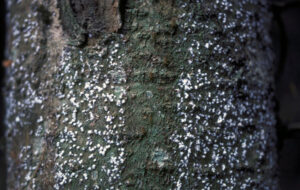
White fluff covers balsam woolly adelgids on the trunk of a fir tree. / Photo Credit: Bugwood.org
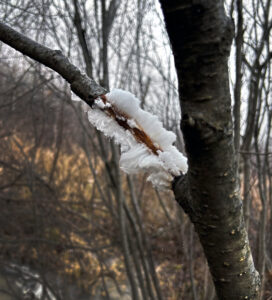
A photo of fluffy, white “hair ice” which has formed on a dead branch. / Photo Credit: Kaitlin Miesbauer
